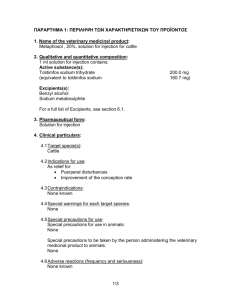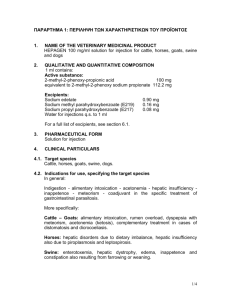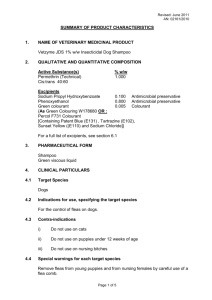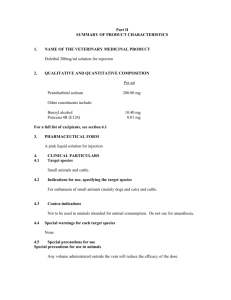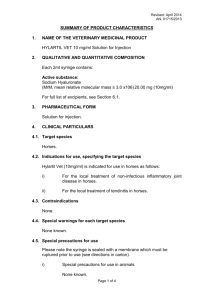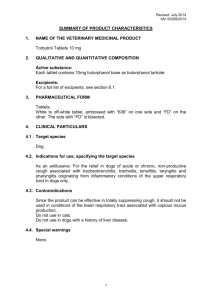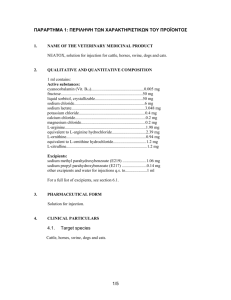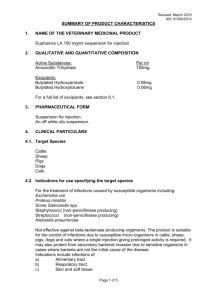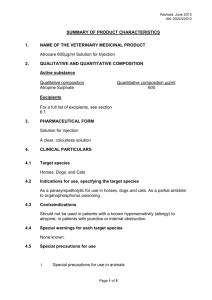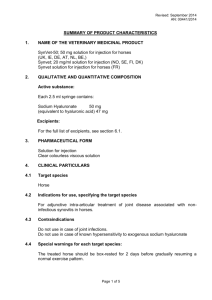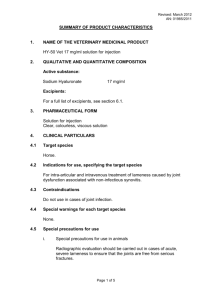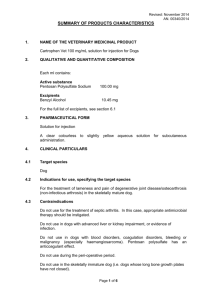250mg/ml - Veterinary Medicines Directorate
advertisement
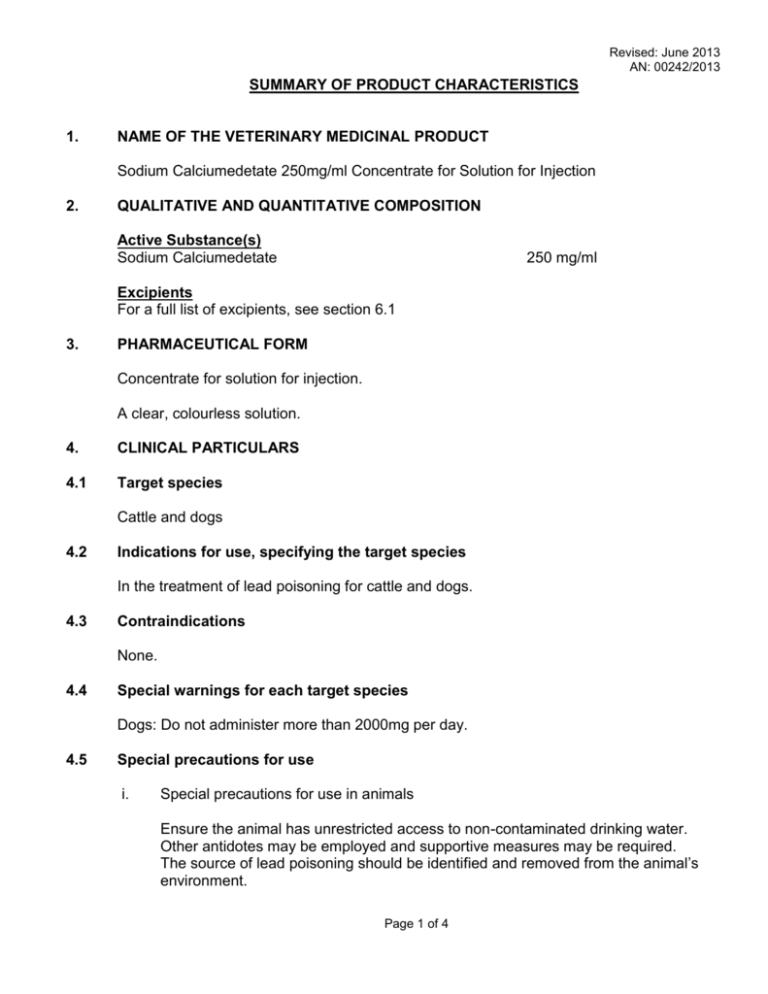
Revised: June 2013 AN: 00242/2013 SUMMARY OF PRODUCT CHARACTERISTICS 1. NAME OF THE VETERINARY MEDICINAL PRODUCT Sodium Calciumedetate 250mg/ml Concentrate for Solution for Injection 2. QUALITATIVE AND QUANTITATIVE COMPOSITION Active Substance(s) Sodium Calciumedetate 250 mg/ml Excipients For a full list of excipients, see section 6.1 3. PHARMACEUTICAL FORM Concentrate for solution for injection. A clear, colourless solution. 4. CLINICAL PARTICULARS 4.1 Target species Cattle and dogs 4.2 Indications for use, specifying the target species In the treatment of lead poisoning for cattle and dogs. 4.3 Contraindications None. 4.4 Special warnings for each target species Dogs: Do not administer more than 2000mg per day. 4.5 Special precautions for use i. Special precautions for use in animals Ensure the animal has unrestricted access to non-contaminated drinking water. Other antidotes may be employed and supportive measures may be required. The source of lead poisoning should be identified and removed from the animal’s environment. Page 1 of 4 Revised: June 2013 AN: 00242/2013 ii. Special precautions for the person administering the veterinary medicinal product to animals If accidentally injected to humans, obtain medical help promptly and show the doctor this warning. Advice to doctor As excretion is predominantly renal, an adequate urinary flow must be established and maintained. Monitoring of proteinuria and haematuria, and of renal function is advisable. Monitoring of zinc levels may also be required as Sodium Calciumedetate can chelate with several endogenous metals. Wash hands after use. iii. Other precautions None 4.6 Adverse reactions (frequency and seriousness) The kidneys of animals with high lead burdens may become overloaded when Sodium Calciumedetate is given, especially if the chelator is administered too rapidly, with resulting adverse kidney reactions or occasional deaths. Overdosage may result in temporary nephroses. 4.7 Use during pregnancy, lactation or lay None 4.8 Interaction with other medicinal products and other forms of interaction Not applicable. 4.9 Amount(s) to be administered and administration route Dilute immediately before use with sufficient Sodium Chloride Intravenous Infusion BP or Glucose Intravenous Infusion BP to give a 5% (i.e. 50mg/ml) solution of Sodium Calciumedetate, e.g. 1ml Sodium Calciumedetate injection + 4ml diluent. Cattle: 75mg/kg bodyweight - See Withdrawal Periods. Dogs: 75mg/kg bodyweight; total daily dose for dogs, not more than 2000mg. Give by slow intravenous (i.v.) injection. Administer in 4 equally divided doses per day, i.e. every 6 hours, for 2-5 days. Repeat the treatment course after two or three days rest, as necessary, if signs of lead poisoning are still present. Take adequate precautions to maintain sterility. Ensure the animal has unrestricted access to non-contaminated drinking water. Page 2 of 4 Revised: June 2013 AN: 00242/2013 4.10 Overdose (symptoms, emergency procedures, antidotes), if necessary Overdosage may result in temporary nephroses, adverse kidney reactions or occasional deaths. Supportive measures should be included to ensure diuresis whilst maintaining adequate hydration. The animal should be given a rest period before any further administration of the Sodium Calciumedetate injection. 4.11 Withdrawal period(s) Cattle (meat): Cattle should not be slaughtered for human consumption until 3 months have elapsed from the removal of the source of poisoning and the clinical recovery of the animal is achieved. Cattle (milk): Milk should be discarded until after milk lead levels on two successive days have been determined and been found to be below 0.02 ppm (i.e. below 20µg/l). Bulk milk lead levels may be determined in outbreaks of lead poisoning in herds. 5. PHARMACOLOGICAL PROPERTIES Pharmacotherapeutic group: Antidotes ATC Vet Code: QV03AB03 5.1 Pharmacodynamic properties Sodium Calciumedetate is a chelating agent used in the treatment of lead poisoning. It mobilises lead from bone and tissues and aids elimination from the body by forming a water-soluble lead complex which is readily excreted via the kidneys. It is also a chelator of other heavy polyvalent ions such as cadmium, but is unsuitable for the treatment of arsenic, mercury or thallium poisoning. 6. PHARMACEUTICAL PARTICULARS 6.1 List of excipients Water for Injections 6.2 Incompatibilities None known 6.3 Shelf life Shelf life of the veterinary medicinal product as packaged for sale: 3 years. Page 3 of 4 Revised: June 2013 AN: 00242/2013 6.4 Special precautions for storage Do not store above 25ºC. 6.5 Nature and composition of immediate packaging 100 ml, Amber, Type II glass vial, with a grey chlorobutyl rubber bung and an aluminium overseal. 6.6 Special precautions for the disposal of unused veterinary medicinal product or waste materials derived from the use of such products, if appropriate Any unused veterinary medicinal product or waste materials derived from such veterinary medicinal products should be disposed of in accordance with local requirements. 7 MARKETING AUTHORISATION HOLDER Animalcare Ltd 10 Great North Way York Business Park Nether Poppleton York YO26 6RB 8. MARKETING AUTHORISATION NUMBER Vm 10347/4011 9. DATE OF FIRST AUTHORISATION Date: 13 January 1995 10. DATE OF REVISION OF THE TEXT Date: June 2013 APPROVED Page 4 of 4 3/07/13
